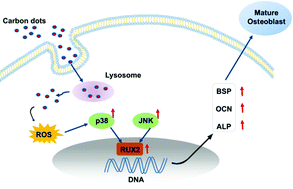Carbon dots for tracking and promoting the osteogenic differentiation of mesenchymal stem cells†
Abstract
Mesenchymal stem cells (MSCs) hold great potential for tissue engineering and regeneration medicine. However, for clinical use, MSCs may be detrimental due to their uncertain fate during the transplantation. It is therefore highly desirable to develop biocompatible nanomaterials to integrate cell fate regulation with monitoring for MSC-based therapy. Herein, we employ recently developed citric acid-based carbon dots (CDs) and their derivatives (Et-IPCA) for labeling and tracking of rat bone marrow mesenchymal stem cells (rBMSCs). We further investigate their biocompatibility and effects on the osteogenic differentiation of rBMSCs. These highly fluorescent probes provide labeling of rBMSCs by internalization without affecting cell viability or inducing apoptosis when the concentration is lower than 50 μg mL−1. Importantly, the presence of the CDs and Et-IPCA facilitates high-efficiency osteogenic differentiation of rBMSCs by promoting osteogenic transcription and enhancing matrix mineralization. Compared to Et-IPCA, CDs considerably provide long-term tracking and promote the differentiation of rBMSCs toward osteoblasts through the ROS-mediated MAPK pathway. Taken together, our results consistently demonstrate that carbon dots are capable of both tracking and enhancing the osteogenic differentiation of MSCs. This study sheds new light on the potential of carbon dots as a bifunctional tool in the thriving field of MSC-based therapy.



 Please wait while we load your content...
Please wait while we load your content...